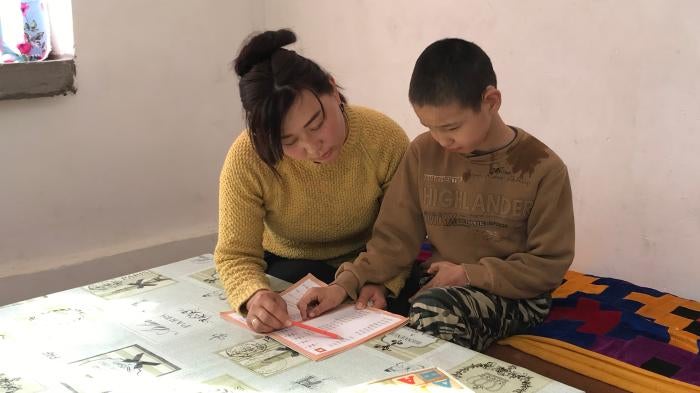Children with Disabilities Face Barriers to Education in Kyrgyzstan
Read a text description of this video
Aida, Adinai’s mother
She says “mom, ““dad,” simple words, but she can’t say or express full sentences, her thoughts, her feelings. Adinai is now 15 years old. She finished eighth grade now, got a certificate. But she still cannot speak.
At six, Adinai went to study at a residential special school. In Kyrgyzstan, a government body evaluates children with disabilities like Adinai and assesses their educational path. While this is only a recommendation, not all parents know that.
Aida, Adinai’s mother
And there they explained to me: “You have a child ... You are not allowed to go to public school. You can only go to the residential special school.”
And most importantly, her studies did not go well. I noticed she couldn’t write, couldn’t read, didn't know the letters.
In 2012, the Kyrgyz government promised to close residential institutions and schools, including several for children with disabilities. Children with disabilities in these institutions are sometimes subject to neglect, discrimination, and inappropriate medical treatment.
But for these places to close, alternative community-based services need to be in place.
Since finishing eighth grade, Adinai’s only option is to go to a rehabilitation center while her mother works. But she will no longer be able to attend when she turns 16 next year.
Aida, Adinai’s mother
I would like to at least find a place where she is taught to read, write, or taught something. But I cannot find such a place.
Rakhat Orozova,, Expert on Inclusive Education
We should provide the right to education, to medical care, to social protection to a child. Only then should we close these institutions and move the child from institution to family
The Kyrgyz government also made a commitment to provide children with disabilities access to an inclusive, quality education But many children face obstacles trying to enroll in schools where they live. Adilet, a ten-year-old with cerebral palsy was not welcomed at his local school.
Aizada, Adilet’s mother
We had problems with the school and the director who said we shouldn’t come and that children will be afraid of him. But we continued going anyway. The director was even angry seeing us. The director gave us permission to attend classes but only once or twice a week. But I stubbornly kept on taking Adilet to school. I wanted to integrate him into society.
Once in school, other issues may arise. School premises may not be accessible for children
Parents say that teachers often were not trained to teach children who have disabilities, particularly if they have intellectual disabilities.
Rakhat Orozova,, Expert on Inclusive Education
Knowing how to teach children with different disabilities, the teacher can then apply this skill to all children and as a result, the learning process for all children is enriched.
Studies show inclusive education benefits all children by promoting tolerance, understanding and diversity. Inclusive education also supports a child with disabilities to participate equally with others in society as they grow up.
Aizada, Adilet’s mother
The children were nice to him. They tried to help him walk, asked which class he needed to go to, and assisted him in getting to the classroom to sit.
Kanetbek is 19 years old and has cerebral palsy.
Kanatbek , 19-year-old with cerebral palsy
At first, they recommended home-based education, but my mother did not want me to sit at home and be isolated. She wanted me to go to school, socialize with classmates and learn to be active.
When I started going to regular school, the children treated me differently.
Some were scared, some wondered why I moved like I did. But through socializing, through knowing me, after half a year, they started looking at me as an ordinary person.
In Kyrgyzstan, children with disabilities still face major barriers to education in the community. While Kyrgyzstan’s effort to close several residential schools for children with disabilities is important, there is much work to do on expanding access to inclusive education.
Aida, Adinai’s mother
Well as you can see, I’m worried for my daughter. She can’t work. There is no education with her. And how will we live in the future?
Aizada, Adilet’s mother
When you see your child’s progress, you become happy. I think we should continue with school and mustn’t skip it.
Kanatbek , 19-year-old with cerebral palsy
I was already thinking what I would do and programming seemed like the best option. Studying, programming, opening my own company where I will program, where I will hire people with disabilities.
(Berlin, December 10, 2020) – Thousands of children with disabilities in Kyrgyzstan are segregated in residential institutions where they can experience neglect, inappropriate medical treatment, and discrimination, Human Rights Watch said in a report published today, on International Human Rights Day.
The 74-page report, “Insisting on Inclusion: Institutionalization and Barriers to Education for Children with Disabilities in Kyrgyzstan,” documents how children are frequently denied quality, inclusive education, in which children with and without disabilities study together in mainstream schools. Children with disabilities are subject to discriminatory government evaluations that often lead to segregation in special schools or at home, Human Rights Watch found. Kyrgyzstan ratified the United Nations Convention on the Rights of Persons with Disabilities (CRPD) in 2019.
Related Content

December 10, 2020
